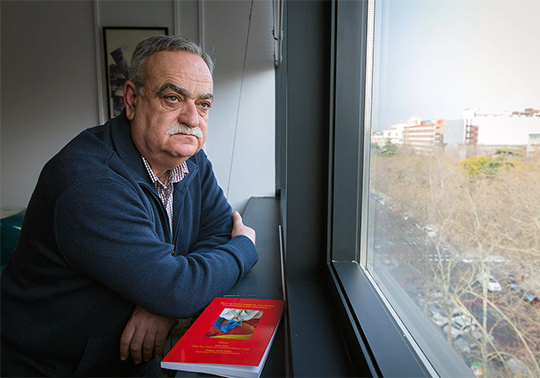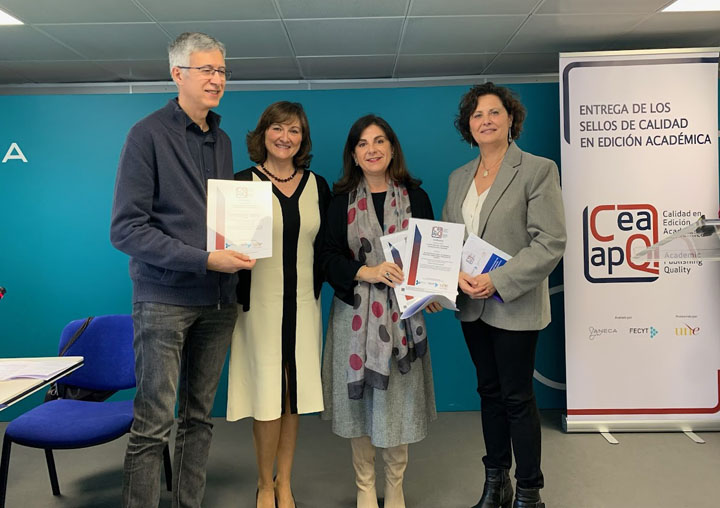‘Spanglish’ reaches out to the Universitat
- March 2nd, 2017

ANNA BOLUDA. Pictures: Miguel Lorenzo.
Livin’ la vida loca is not just the title of a famous song by Ricky Martin; it is also an example of how Spanglish is no longer a language spoken only in the streets and how it has reached music, media and even literary creation. It is also increasingly an object of linguistic study, an approach to which now adds the book New voices on Spanglish, a co-edition of the American Academy of Spanish Language (Anleo) and the Universitat de València, with double edition of the volume there and here.
“It's a hot topic, in the last years Spanglish has been studied at academic entities in a serious way. In 2015 we published a book here, which is the antecedent of this one, and many of its authors have participated in the new volume, with the particularity that this edition has been published from New York by the American Academy of Spanish Language”, explains Enric Serra, professor of linguistics at the Department of Languages Theory of the Universitat de València and co-editor of the book. Among the authors there are several researchers from this department, such as Carlos Hernández, Ricard Morant, Daniel Jorques and Ángel López.
The book is a compilation of several more or less theoretical treatments on Spanglish from different perspectives: linguistics and sociolinguistics, anthropology, educational and didactic or even political, among others.
Language, dialect, identity mark

Defining Spanglish is not easy. “There are those who defend that it is a language and those who say it is only a mix of codes. We define it as a dialect of Spanish that has its own characteristics derived from the place where it is produced, and it is more a communicative practice than a specificity of language, which aims to solve problems of intercommunication between Spanish speakers and English speakers who do not speak Spanish”, explains Enric Serra.
This means Spanglish bridges the speakers of both languages and helps them to understand each other, but it goes beyond that. Although it emerged among disadvantaged immigrant classes, now it is also used by people from consolidated social positions. For some people it is a first approximation to English; for others, totally bilingual speakers of English and Spanish, using Spanglish is a hallmark of identity, an expression of Latin culture.
This has resulted in its occasional inclusion in media targeting the more than fifty million people who use Spanglish in the United States, from single quotes and quotes in magazines or newspapers to more extensive use on radios and televisions, especially in the programming addressed young public, with programmes of great hearing like The Chicas Project or Hecho en Heaven. This presence in the media and advertising feeds the identity value of Spanglish and the links between the people who use it.
About ‘vacunar la carpeta’ and cyber-Spanglish
Much of Spanglish is based on the adaptation of words from English to Spanish, which sometimes leads to curious translations and new meanings of words that already existed in this language. Thus, for example, the English 'to realize' has extended the use of ‘realizar' with the meaning of noticing something, or ‘Trabajo' as synonymous to function, caused by the double meaning of 'to work'.
Spanish speakers do not make a ‘solicitud’, but an ‘aplicación’, derived from ‘application’ in English. And if someone says that they are going to 'vacunar la carpeta en el béisment’, they are going to vacuum the basement carpet, in a very peculiar translation of 'vacuum the carpet in the basement'.
As expected, Spanglish also has a growing presence in the digital environment, with the adaptation of English words that have also become popular here as ‘chatear' or ‘surfear', and others that maintain their character of literal translation like 'linkear', 'delete', 'downloadear' or 'printear'.
All this linguistic production continues to grow and evolve, because Spanglish is one of the most obvious examples of constant linguistic enrichment and a case that is virtually unique in the world. And academic research will continue observing it in detail in order to understand how it works and where is it going.
File in: Llibres i revistes , Teoria dels Llenguatges i Ciències de la Comunicació , Política lingüística , Sociolingüística
















